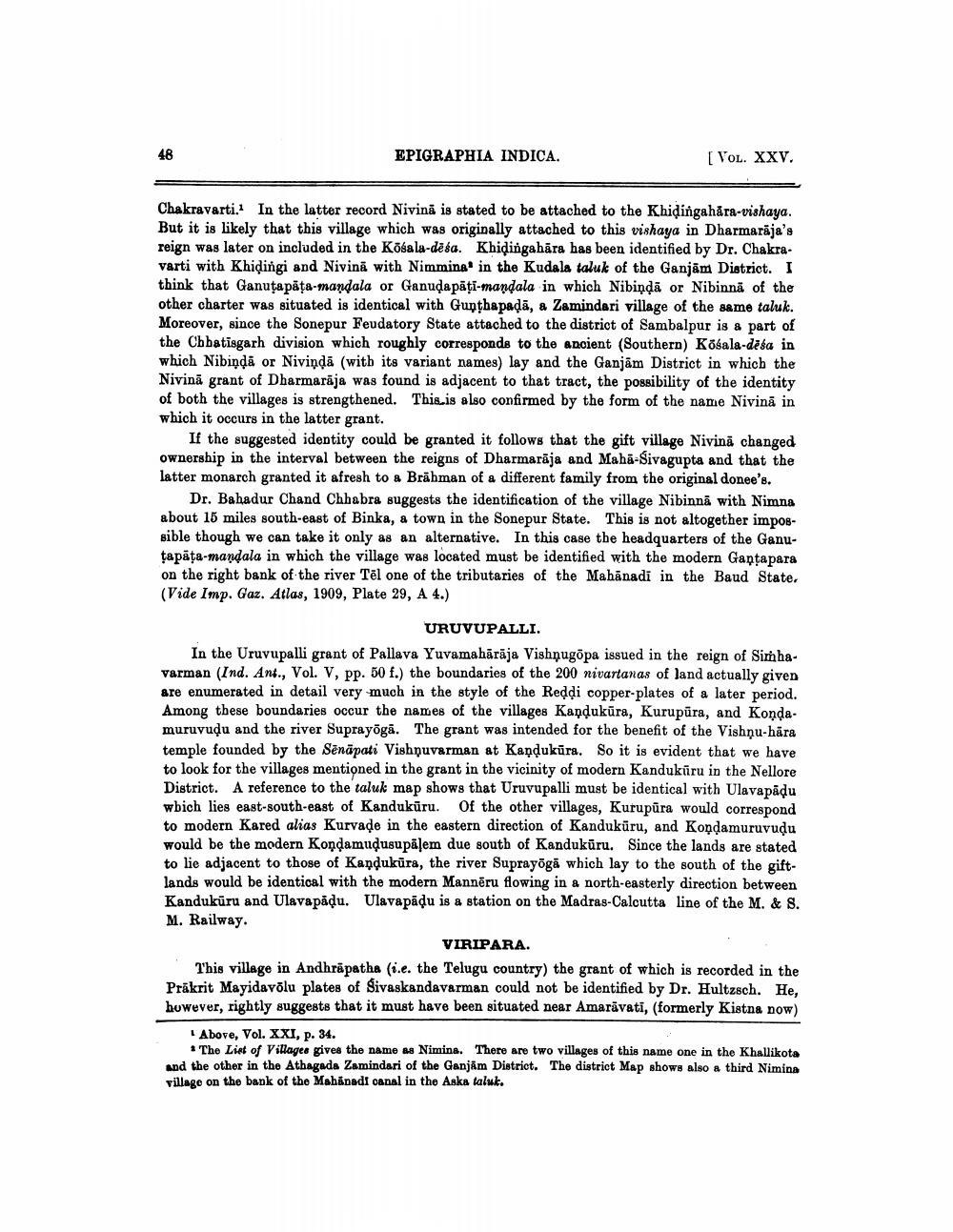________________
48
EPIGRAPHIA INDICA.
[VOL. XXV.
Chakravarti. In the latter record Nivina is stated to be attached to the Khiḍingahara-vishaya. But it is likely that this village which was originally attached to this vishaya in Dharmaraja's reign was later on included in the Kōsala-desa. Khiḍingahara has been identified by Dr. Chakravarti with Khidingi and Nivina with Nimmina in the Kudala taluk of the Ganjam District. I think that Ganuṭapaṭa-mandala or Ganuḍapați-mandala in which Nibiņḍā or Nibinna of the other charter was situated is identical with Gupthapada, a Zamindari village of the same taluk. Moreover, since the Sonepur Feudatory State attached to the district of Sambalpur is a part of the Chhatisgarh division which roughly corresponds to the ancient (Southern) Kōsala-desa in which Nibiṇḍā or Niviņḍā (with its variant names) lay and the Ganjam District in which the Nivina grant of Dharmaraja was found is adjacent to that tract, the possibility of the identity of both the villages is strengthened. This is also confirmed by the form of the name Nivina in which it occurs in the latter grant.
If the suggested identity could be granted it follows that the gift village Nivina changed ownership in the interval between the reigns of Dharmaraja and Maha-Sivagupta and that the latter monarch granted it afresh to a Brahman of a different family from the original donee's.
Dr. Bahadur Chand Chhabra suggests the identification of the village Nibinna with Nimna about 15 miles south-east of Binka, a town in the Sonepur State. This is not altogether impossible though we can take it only as an alternative. In this case the headquarters of the Ganutapaṭa-mandala in which the village was located must be identified with the modern Ganṭapara on the right bank of the river Tel one of the tributaries of the Mahanadi in the Baud State. (Vide Imp. Gaz. Atlas, 1909, Plate 29, A 4.)
URUVUPALLI.
In the Uruvupalli grant of Pallava Yuvamahārāja Vishnugopa issued in the reign of Simhavarman (Ind. Ant., Vol. V, pp. 50 f.) the boundaries of the 200 nivartanas of land actually given are enumerated in detail very much in the style of the Reddi copper-plates of a later period. Among these boundaries occur the names of the villages Kandukura, Kurupura, and Kondamuruvudu and the river Suprayoga. The grant was intended for the benefit of the Vishnu-hara temple founded by the Senapati Vishnuvarman at Kaṇḍukura. So it is evident that we have to look for the villages mentioned in the grant in the vicinity of modern Kandukuru in the Nellore District. A reference to the taluk map shows that Uruvupalli must be identical with Ulavapāḍu which lies east-south-east of Kandukuru. Of the other villages, Kurupura would correspond to modern Kared alias Kurvade in the eastern direction of Kandukuru, and Kondamuruvudu would be the modern Kondamuḍusupalem due south of Kandukuru. Since the lands are stated to lie adjacent to those of Kandukura, the river Suprayoga which lay to the south of the giftlands would be identical with the modern Mannēru flowing in a north-easterly direction between Kandukuru and Ulavapadu. Ulavapadu is a station on the Madras-Calcutta line of the M. & S. M. Railway.
VIRIPARA.
This village in Andhrapatha (i.e. the Telugu country) the grant of which is recorded in the Prakrit Mayidavōlu plates of Sivaskandavarman could not be identified by Dr. Hultzsch. He, however, rightly suggests that it must have been situated near Amaravati, (formerly Kistna now)
Above, Vol. XXI, p. 34.
The List of Villages gives the name as Nimina. There are two villages of this name one in the Khallikota and the other in the Athagada Zamindari of the Ganjam District. The district Map shows also a third Nimina village on the bank of the Mahanadi canal in the Aska taluk.




